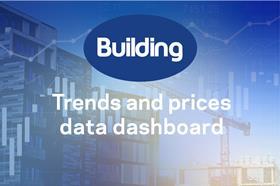Allan Wilé²Ô of Glenigan analyses recent construction market figures highlighted by ºÃÉ«ÏÈÉúTV’s trends and prices data dashboard
Construction continues to face significant cost pressures, but there are encouraging signs that material prices are at least now stabilising after the sharp hikes seen over the last two years.
Overall construction material prices rose by 11% last year, having increased by 23% in 2021. However overall material prices have been easing slightly since the middle of 2022, slipping by 3% between August 2022 and February 2023.

Whilst overall prices have stabilised, some key product categories have seen a marked weakening in prices over the last six months, as highlighted by ºÃÉ«ÏÈÉúTV’s trends and prices data dashboard.
Concrete reinforcing bars fell by 14% between August and February. Steel prices had previously been driven sharply higher by war-induced panic stock-building and the gradual unwinding of stock levels has contributed to the recent easing in prices. Imported timber prices have fallen 17% over the same period as the outlook for the UK housing market and house building have turned down.
In contrast the cost of energy-intensive products such as cement, precast concrete and insulating materials have continued to rise. The price of insulation rose by 12% over the six months to February and were 40% higher than a year earlier.
Steel prices had previously been driven sharply higher by war-induced panic stock-building and the gradual unwinding of stock levels has contributed to the recent easing in prices.
Labour pressures have also eased slightly in recent months. Average earnings in construction rose by 5.7% over the year to February. This compares with annual growth of 6% last year and 6.1% in 2021. Labour availability appears to have also improved since the middle of last year.
Construction vacancies have fallen over the last five months. At 41,000, the number of construction vacancies in February was 15% down on a year ago.
Trends and prices data dashboard

Your one-stop-shop for the all the latest price changes and trends in the building materials, energy, housing and construction labour markets.
ºÃÉ«ÏÈÉúTV’s trends and prices data dashboard pulls together figures from 14 different datasets into easy-to-use line graphs, bar charts and animated visualisations.
The easing in labour market pressures reflects a moderation in industry employment growth. Total construction employment grew by 1.9% to 2.3 million during 2022, compared to 3.5% during the previous year. Despite this growth, industry employment remains 2.9% below pre-pandemic levels.
The impact of the rise in material and labour costs is evident in the overall cost of construction. Average construction costs rose by 1.5% in the final quarter of 2022 to stand 9.7% up on a year earlier. New build projects are typically more material intensive and at 11.8% saw the sharpest annual increase in costs. In comparison repair and maintenance projects typically rose by 5.5%.
The recent overall stabilising in material prices accordingly points to a moderation in construction inflation over the coming months especially for new build projects.
Allan Wilé²Ô is economics director at Glenigan.




























No comments yet